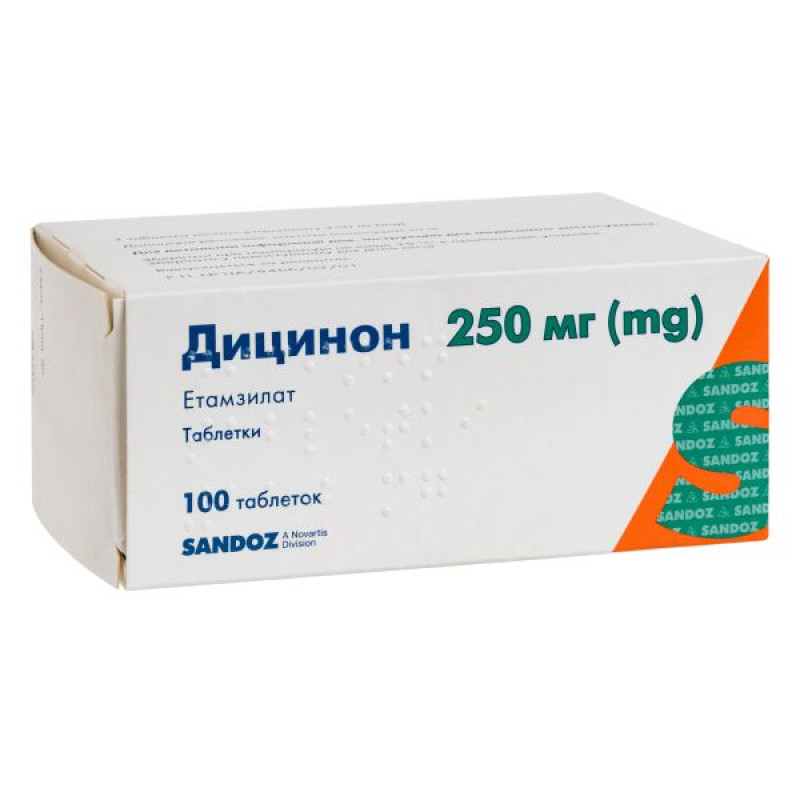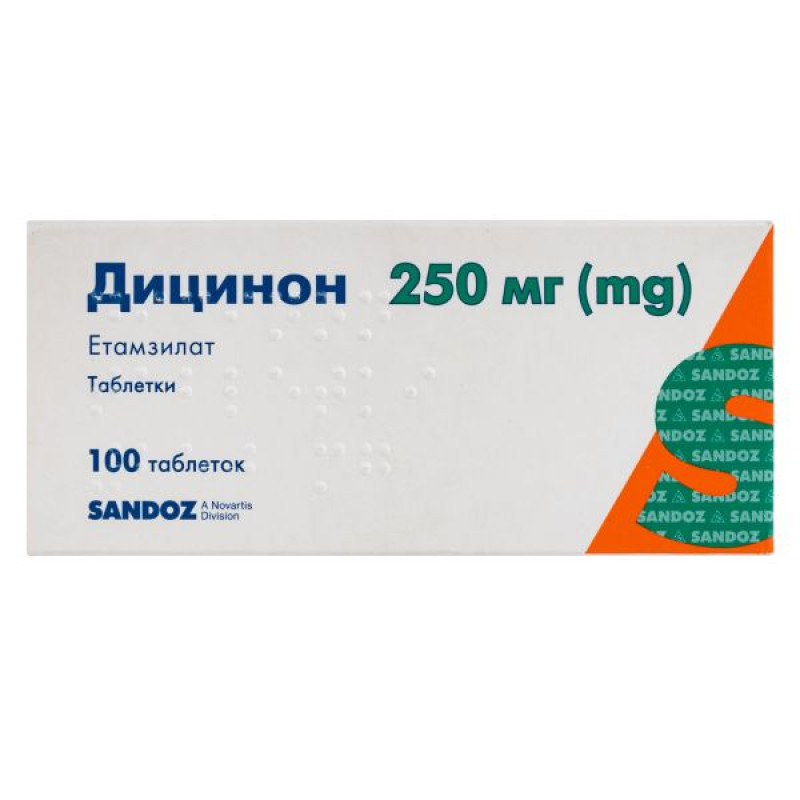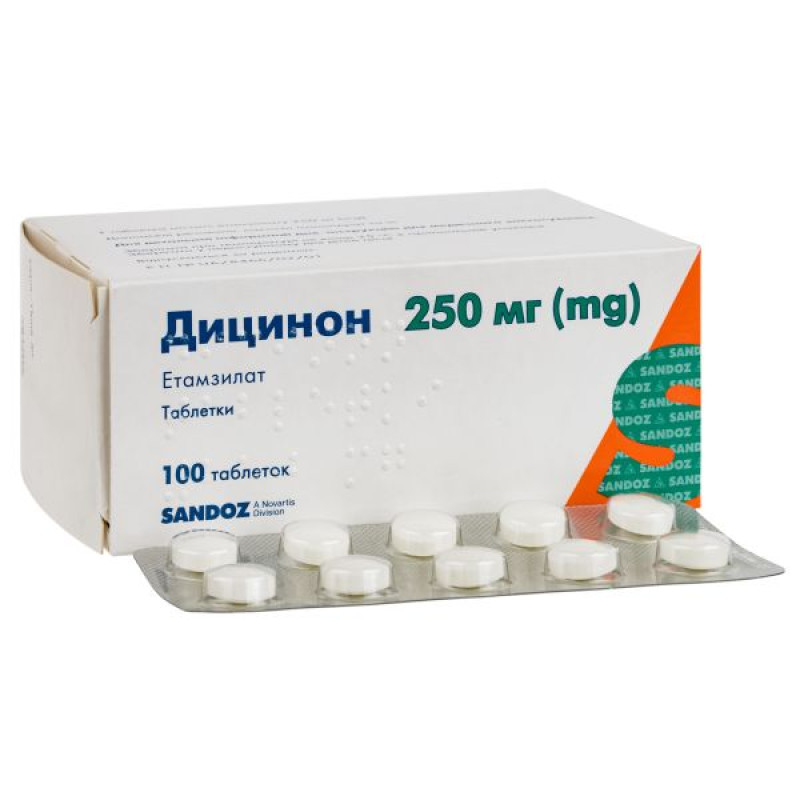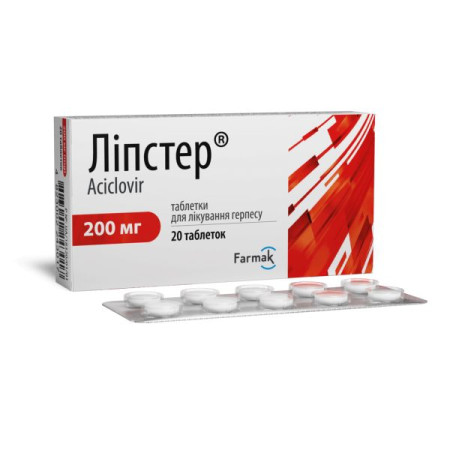Dicinon tablets 250 mg blister No. 100

Instructions for Dicinon tablets 250 mg blister No. 100
Composition
active ingredient: etamzilate;
1 tablet contains 250 mg of etamsylate;
Excipients: anhydrous citric acid, corn starch, lactose monohydrate, povidone, magnesium stearate.
Dosage form
Pills.
Main physicochemical properties: white or almost white round, biconvex tablets.
Pharmacotherapeutic group
Antihemorrhagic agents. Other hemostatic agents for systemic use.
ATX code B02B X01.
Pharmacological properties
Pharmacodynamics
Etamzilate is a means for preventing and stopping bleeding. It affects the first stage of the hemostasis mechanism (interaction between the endothelium and platelets). Dicinone increases platelet adhesion, normalizes the stability of capillary walls, thereby reducing their permeability, inhibits the biosynthesis of prostaglandins, which cause platelet disaggregation, vasodilation and increased capillary permeability. As a result, bleeding time is significantly reduced, blood loss is reduced.
Pharmacokinetics
Etamsylate is almost completely absorbed from the gastrointestinal tract, reaching peak serum concentrations 4 hours after administration. Approximately 95% of the drug is bound to plasma proteins.
Approximately 72-80% of the administered dose is excreted unchanged in the urine within the first 24 hours. Etamsylate crosses the placental barrier. It is unknown whether etamsylate is excreted in breast milk.
Indication
Dicinone is prescribed for the prevention and control of hemorrhages in superficial and internal capillaries of various etiologies, especially if the bleeding is caused by damage to the endothelium:
prevention and treatment of bleeding during and after surgical operations in otolaryngology, gynecology, obstetrics, urology, dentistry, ophthalmology and plastic surgery;
prevention and treatment of capillary bleeding of various etiologies and localizations: hematuria, metrorrhagia, primary hypermenorrhea, hypermenorrhea in women with intrauterine contraceptives, nosebleeds, bleeding gums.
Contraindication
Hypersensitivity to etamzilate or any other component of the drug. Acute porphyria, increased blood clotting, thrombosis, thromboembolism. Hemoblastosis (lymphatic and myeloid leukemia, osteosarcoma) in children.
Interaction with other medicinal products and other types of interactions
Taking etamsylate before the administration of dextrans (e.g., rheopoliglyukin) prevents their antiplatelet effect, and after the administration of the latter, it does not have a hemostatic effect. Interaction with aminocaproic acid, vikasol is possible.
Application features
The drug should be used with caution in patients with a history of thrombosis or thromboembolism. The drug is ineffective in cases of low platelet count.
In case of hemorrhagic complications associated with anticoagulant overdose, it is recommended to use specific antidotes.
Before starting treatment, other causes of bleeding should be excluded. If no improvement is observed when using Dicinon to reduce excessive and/or prolonged menstrual bleeding, possible pathological causes (e.g., the presence of uterine fibroids) should be excluded.
In case of skin reactions or fever, treatment should be discontinued and a doctor should be consulted, as this may be a sign of hypersensitivity.
The drug contains lactose, therefore patients with rare hereditary forms of galactose intolerance, lactase deficiency or glucose-galactose malabsorption syndrome should not use Dicinon.
Use in patients with renal failure.
The safety and efficacy of etamzilate have not been studied in patients with renal insufficiency. Since etamzilate is almost completely excreted by the kidneys, the dose of the drug should be reduced in cases of renal insufficiency.
Laboratory tests.
In therapeutic doses, etamzilate may reduce test results when determining creatinine levels.
Use during pregnancy or breastfeeding
There is no reliable data on the effect of Dicinon on the fetus, therefore the drug is contraindicated in the 1st trimester of pregnancy. In the 2nd and 3rd trimesters of pregnancy, the use of the drug is possible if the benefit to the mother outweighs the risk to the fetus.
Breastfeeding should be discontinued when using the drug.
Ability to influence reaction speed when driving vehicles or other mechanisms
It has no effect, but dizziness may occur when using the drug, which should be taken into account when driving or using other mechanisms.
Method of administration and doses
For oral use. Take the tablets during or after meals, with a small amount of water.
The daily dose for adults is usually 2 tablets 2-3 times a day (1000-1500 mg).
Before surgery, take 1-2 tablets (250-500 mg) 1 hour before surgery.
For menorrhagia, prescribe 2 tablets 3 times a day (1500 mg) for 10 days, starting from the 5th day of the expected onset of menstruation until the 5th day of the next menstrual cycle.
The daily dose for children is half the dose for adults.
The drug should be used with caution in patients with hepatic or renal insufficiency.
Children
The drug should be used in children over 6 years of age. Do not prescribe to children with hemoblastosis.
Overdose
No data available. In case of overdose, treatment is symptomatic.
Side effects
From the nervous system: headache, dizziness, hot flashes, paresthesia of the lower extremities.
On the part of the digestive system: nausea, vomiting, diarrhea, abdominal discomfort.
On the part of the immune system: hypersensitivity, allergic reactions, skin rash, urticaria, itching, a case of angioedema has been described.
Musculoskeletal system: arthralgia.
From the blood and lymphatic system: agranulocytosis, neutropenia, thrombocytopenia.
Vascular: thromboembolism.
Others: asthenia, fever, acute porphyria.
All side effects are mild and transient.
Severe leukopenia was more common in children treated with etamsylate to prevent bleeding in acute lymphoblastic and myeloid leukemia.
Expiration date
5 years.
Storage conditions
Store at a temperature not exceeding 25 °C in the original packaging.
Keep out of reach of children.
Packaging
10 tablets in a blister; 10 (10 × 10) blisters in a cardboard box.
Vacation category
According to the recipe.
Producer
Lek Pharmaceutical Company Ltd.
Address
Verovškova 57, Ljubljana 1526, Slovenia (full-cycle production)
Trimlini, 2D, 9220 Lendava, Slovenia (primary and secondary packaging, batch release authorization).
There are no reviews for this product.
There are no reviews for this product, be the first to leave your review.
No questions about this product, be the first and ask your question.


















